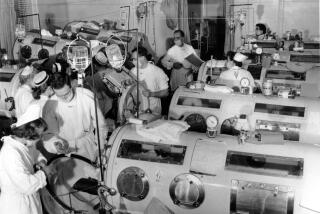Edwin D. Kilbourne dies at 90; virologist developed flu vaccine
Dr. Edwin D. Kilbourne, a virologist who figured out how to manufacture a new influenza vaccine each year and was a principal advisor to the U.S. government on flu, died Feb. 21 in Branford, Conn. He was 90. No cause of death was released.
Kilbourne was involved in every aspect of preparing vaccines for the influenza season, understanding the genetics of the virus, manipulating it to create a version that would grow in eggs, and helping make the recommendation of what the vaccine formulation should be each year, Food and Drug Administration officials said on his formal retirement in 2002.
Without his efforts, the United States may not have had an annual influenza vaccine — or its development might have been delayed for years or decades.
Kilbourne also played a crucial role in the swine flu scare of 1976.
The influenza virus is a highly mutable infectious agent: developing an immunity to one year’s circulating virus provides little benefit for the next year’s, which is why people have to get new flu shots annually. A team of experts analyze which viruses are circulating and make their best guess about which three should be included in the vaccine for the coming season.
The vaccine is prepared by growing the virus in fertilized eggs, then killing it and using the components to produce immunity in humans. Unfortunately, many of the viruses that manufacturers need to use in the vaccines grow very poorly in eggs — much too poorly for manufacturers to amass a sufficient quantity of virus to produce a vaccine in time for the upcoming flu season.
In 1960, Kilbourne discovered that he could use strains of influenza that grew readily in eggs and add to them key parts of the viruses that researchers wished to incorporate in a vaccine. The different strains would mix, or recombine, in the test tube and create an effective vaccine that would grow rapidly.
“This was the first genetically engineered vaccine of any kind,” Kilbourne said later.
For years, Kilbourne’s was the only lab that could do this, but eventually he taught researchers at the National Institutes of Health and elsewhere how to do it as well.
The swine flu episode of 1976 was a miscalculation that Kilbourne later termed “my 15 minutes of infamy.”
The world had suffered global flu epidemics in 1957 and 1968. Kilbourne was one of a small group of researchers who believed epidemics would recur in 10-year cycles and, when a soldier at Fort Dix, N.J., died of a particularly virulent strain of flu virus in February 1976, he argued powerfully that another epidemic was imminent. He developed a vaccine for the strain, called swine flu, and called for widespread immunization.
Kilbourne and others convinced President Ford that the virus bore a strong resemblance to the flu virus responsible for the 1918 pandemic, and Ford ordered that 200-million Americans be vaccinated. Immunizations began in October and about 40 million Americans received the shots before the program was halted in December amid reports that 54 recipients had developed a paralyzing neurological condition called Guillain-Barre syndrome. The virus itself never spread outside Fort Dix.
Ultimately, more than 500 vaccine recipients contracted the syndrome, but scientists have never agreed whether the vaccine was responsible because studies did not show a link between the vaccine and the disorder.
Kilbourne remained unapologetic for his role in the episode. “Better a vaccine without an epidemic than an epidemic without a vaccine,” he said later.
Edwin Dennis Kilbourne was born in Buffalo, N.Y., on July 10, 1920, and spent his early childhood in the Dominican Republic, where his father was an executive with the West Indies Sugar Corp. He graduated from Cornell University in 1942 and Cornell Medical College in 1944. After joining the Army Medical Corps, he became intrigued with influenza while treating soldiers.
During his prolific career, he performed research at the Rockefeller Institute and was on the faculty at Tulane Medical School, Cornell University, Mount Sinai Medical School and New York Medical College. He was a longtime advisor to the National Institutes of Health, the Centers for Disease Control and Prevention and the Food and Drug Administration and received numerous awards for his work.
He has also published humorous verses in popular magazines, often inspired by whimsical scientific news items about sexual activity among other species. The poems were compiled in his 2005 book “Strategies of Sex.”
For more than 35 years, he participated in the Ho-Ho-Kus (N.J.) Men’s Bowling League, driving there even after the family moved to Connecticut.
Kilbourne is survived by his wife of 58 years, the former Joy Schmid; a sister, a half-sister, four sons and eight grandchildren.





